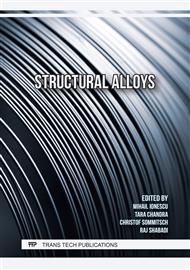p.121
p.129
p.137
p.143
p.149
p.157
p.163
p.169
p.177
A New Approach for Sintering Simulation of Irregularly Shaped Powder Particles
Abstract:
In sintering simulation, there are basically two approaches: microscale simulation, in which distinct particles or pores are regarded, and macroscale, where the porous body is regarded as continuum with variable density.Material parameters of the latter can be determined by experiment or by microscale models.Current microscale sintering models mainly use circular resp.~spherical particle geometries to represent the actual shape of real particles.However, sintering behavior is heavily dependent on the morphology of the powder particles, since sintering progress is driven by reduction of the bound surface energy.So current models neglect the influence of local contact morphology.Here, a finite differences based microscopic sintering model is presented, which is capable to work with irregular particle geometries.Asymmetric particle contacts in shape and substance are possible within.The differences between circular particle contacts and asymmetric ones are investigated.Furthermore, a statistical way of describing the morphology of powder particles and its inclusion into sintering simulation using Monte Carlo techniques are shown.Morphology data are obtained from microscopic imaging by extracting the 2D contours.The particles' contour lines are fitted to a parameterized shape function including ovality and first order waves to obtain a description of the particles' fine shapes.From the statistical distribution of the shape parameters, randomized particle groupings are sampled as input for microscopic sintering simulation.Statistical analysis of the samples' sintering behaviors leads to statements about the powder's.Comparisons to classical spherical modelling are given.
Info:
Periodical:
Pages:
157-161
Citation:
Online since:
December 2023
Price:
Сopyright:
© 2023 Trans Tech Publications Ltd. All Rights Reserved
Share:
Citation:



